IASbaba's Daily Current Affairs Analysis
Archives
(PRELIMS & MAINS Focus)
Syllabus
- Prelims – Science and technology
Context: Recent studies have reported that ‘Bisphenol A’, may shorten the life cycle of a mosquito and lead to a population explosion.
About Bisphenol A:
- Bisphenol A is a synthetically obtained colourless, crystalline organic compound that occurs in the solid phase belonging to the diphenylmethane group.
It is soluble in organic solvents but poorly dissolves in water
- It is also used as eyewear glasses. It is a chemical is widely used to soften plastics, paints, and other products.
- It is known to impair reproduction and development in aquatic organisms.
- Its exposure is delayed larval development and pupation time in common fruit fly (Drosophila melanogaster).
Uses of Bisphenol A :
- BPA polycarbonate plastics are very sturdy in nature and are used to make large variants of microwave-proof utensils.
- It is used as a material for safety glasses, bulletproof windows and helmets.
- Bisphenol A acts as a component in epoxy resins that are very good coating agents and therefore is used for the protective coating of pipelines and to cover the inner surface of food cans.
- It is used in many medical devices such as heart-lung machines, incubators, artificial kidneys, dental fillers, and sealants.
- It is also used as eyewear glasses , due to their optical clarity.
Environmental impacts of Bisphenol A:
- BPA can enter the environment directly through the leaching of chemicals or degradation of materials containing bisphenol A and may render the land unfertile and barren making it unsuitable for agriculture.
- It affects the growth and reproduction of marine life.
- It causes endocrine effects in fish, amphibians, and reptiles.
Adverse effects of Bisphenol A on human health:
- When ingested, the chemical disrupts the endocrine system by interfering with the hormones and affecting the brain and prostate gland of foetuses, infants, and children.
- It can cause high blood pressure, diabetes and cardiovascular disease in adults.
- BPA is a xenoestrogen and mimics estrogen present in the body, thus exhibiting hormone-like properties.
- It can indirectly aid in the spread of vector-borne diseases in humans and animals.
Source: DOWN TO EARTH
Previous Year Questions
Q.1) Bisphenol A (BPA), a cause of concern, is a structural/key component in the manufacture of which of the following kinds of plastics? (2021)
- Low-density polyethylene
- Polycarbonate
- Polyethylene terephthalate
- Polyvinyl Chloride
Q.2) “Triclosan” is considered harmful when exposed to high levels for a long time, is most likely present in which of the following? (2021)
- Food preservatives
- Fruit-ripening substances
- Reused plastic containers
- Toiletries
Syllabus
- Prelims – Environment and Ecology
Context : Recently, experts reported that suitable climatic and beach conditions are the reasons for the early mass nesting of Olive Ridley turtles.
About Olive Ridley turtles:
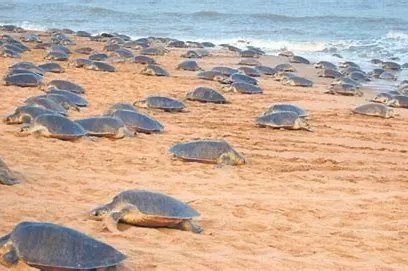
- The Olive ridley turtles are the smallest and most abundant of all sea turtles found in the world.
- They are found to be inhabiting the warm waters of the Pacific, Atlantic, and Indian oceans.
- They are carnivores and feed mainly on jellyfish, shrimp, snails, crabs, molluscs, and a variety of fish and their eggs.
- The males and females grow to the same size.
- These turtles, along with their cousin the Kemps ridley turtle, are best known for their unique mass nesting called Arribada, where thousands of females come together on the same beach to lay eggs.
- The coast of Orissa in India is the largest mass nesting site for the Olive-ridley, followed by the coasts of Mexico and Costa Rica.
- The species is recognized as Vulnerable by the IUCN Red list.
- They lie in Scheduled 1 of the Wildlife Protection Act, 1972
- They are in Appendix I of the CITES.
About Rushikulya river :
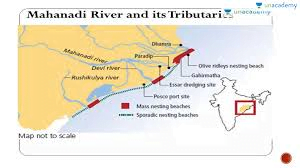
- It is one of the major rivers in Odisha and covers the entire catchment area in the districts of Kandhamal and Ganjam.
- The Rushikulya originates at an elevation of about 1000 meters from the Daringbadi hills of the Eastern Ghats.
- The tributaries of the Rushikulya River are Dhanei, Badanadi, and Baghua.
- It does not have any delta in its mouth region.
- This river is extremely rich in mineral wealth and some of the prime ones include-Lime stone, sand talc, grinding materials, black sand, and clay.
- This is one of the remote areas for mass nesting and is regarded as a site of Ridley Olive sea turtles.
Source: DOWN TO EARTH
Previous Year Questions
Q.1) Consider the following pairs: (2022)
Wetland/Lake: Location
- Hokera Wetland Punjab
- Renuka Wetland Himachal Pradesh
- Rudrasagar Lake Tripura
- Sasthamkotta Tamil Nadu
How many pairs given above are correctly matched?
- Only one pair
- Only two pairs
- Only three pairs
- All four pairs
Q.2) Which of the following is a filter feeder? (2022)
- Catfish
- Octopus
- Oyster
- Pelican
Syllabus
- Prelims – Polity and Governance
Context: Recently, the CJI reprimanded a student for filing a caveat in a petition seeking menstrual leave.
About Caveat
- A caveat refers to a “formal notice requesting the court to refrain from taking some specified action without giving prior notice to the person lodging the caveat.”
- The person lodging the caveat is called a “caveator”.
- The term “caveat” is not expressly defined anywhere except in the Calcutta High Court’s 1978 ruling in the “Nirmal Chandra Dutta vs Girindra Narayan Roy” case.
- It is a precautionary measure taken against the grant of probate or letters of administration, as the case may be, by the person lodging the caveat.
- Section 148A of the Civil Procedure Code (CPC) , elaborating upon a caveat was inserted by the Amendment Act of 1976, after the Law Commission’s recommendation.
- Any person can lodge a caveat in a Court.
- The caveator or the person lodging is also required to serve a notice of the caveat by “registered post” to the person on whose plea they are lodging the application
- It was recently used in the “Shailendra Mani Tripathi v. Union of India & Others”, a petition seeking menstrual leave for female students and working women across Indian institutions.
Source: The Indian Express
Previous Year Questions
Q.1) With reference to the writs issued by the Courts in India, consider the following statements: (2022)
- Mandamus will not lie against a private organization unless it is entrusted with a public duty.
- Mandamus will not lie against a Company even though it may be a Government Company.
- Any public-minded person can be a petitioner to move the Court to obtain the writ of Quo Warranto.
Which of the statements given above is correct?
- 1 and 2 only
- 2 and 3 only
- 1 and 3 only
- 1, 2 and 3
Q.2) With reference to Indian Judiciary, consider the following statements. (2021)
- Any retired judge of the Supreme Court of India can be called back to sit by the Chief Justice of India with the prior permission of the President of India.
- A High court in India has the power to review its own judgment as the Supreme Court does.
Which of the statements given above is/are correct?
- 1 only
- 2 only
- Both 1 and 2
- Neither 1 nor 2
Syllabus
- Prelims – Polity and Governance
Context: Recently, a Congress leader was booked under IPC sections including 153A, 505, and 295A.
About Section 153A of the Indian Penal Code (IPC):
- Origin: In the pre-Independence Rangila Rasool case, the Punjab High Court had acquitted the Hindu publisher of a tract that had made disparaging remarks about the private life of the Prophet, and had been charged under Section 153A.
- Section 153A of the Indian Penal Code (IPC) penalizes “promoting enmity between different groups on grounds of religion, race, place of birth, residence, language, etc., and doing acts prejudicial to maintenance of harmony”.
- This is punishable with imprisonment up to three years, with a fine, or with both.
- The provision was enacted in 1898 and was not in the original penal code.
- Section 505, penalizes “statements conducing to public mischief” .
- The data from the National Crime Records Bureau (NCRB) show that the rate of conviction for Section 153A is very low.
- In 2020, the cases registered were six times higher than the cases in 2014.
- However, the conviction rate in 2020 was 20.2%, suggesting that the process often becomes the punishment.
Safeguards against misuse of Section 153 A:
- Sections 153A and 153B require prior sanction from the government for initiating prosecution.
- This is required before the trial begins, and not at the stage of preliminary investigation.
- To curb indiscriminate arrests, the Supreme Court laid down a set of guidelines in its 2014 ruling in Arnesh Kumar v State of Bihar.
- According to this, for offenses that carry a sentence of fewer than seven years, the police cannot automatically arrest an accused before investigation.
- In a 2021 ruling, the SC said that the state will have to prove intent for securing a conviction under Section 153A.
Source: THE INDIAN EXPRESS
Previous Year Questions
Q.1) With reference to India, consider the following statements: (2022)
- When a prisoner makes out a sufficient case, parole cannot be denied to a such prisoner because it becomes a matter of his/her right.
- State Governments have their own Prisoners Release on Parole Rules.
Which of the statements given above is/are correct?
- 1 only
- 2 only
- Both 1 and 2
- Neither 1 nor 2
Q.2) With reference to India, consider the following statements: (2022)
- Judicial custody means an accused is in the custody of the concerned magistrate and such an accused is locked up in a police station, not in jail.
- During judicial custody, the police officer in charge of the case is not allowed to interrogate the suspect without the approval of the court.
Which of the statements given above is/are correct?
- 1 only
- 2 only
- Both 1 and 2
- Neither 1 nor 2
Syllabus
- Prelims – Science and technology
Context: In recent studies, the medicinal plant commonly called Borthekera in Assamese was found to have cardioprotective potential.
About Borthekera:
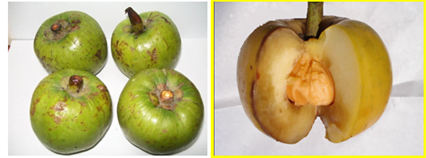
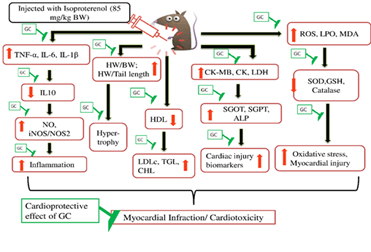
- Garcinia pedunculata, commonly called ‘Borthekera’ is a medicinal plant found in Assam.
- The tree is endemic to the south-eastern regions of Asia such as parts of Myanmar and north-eastern parts of India.
- It is traditionally forbidden for raw consumption.
- It has been found to protect from heart diseases.
Uses of Borthekera :
- The administration of the dried pulp of its ripe fruit reduces cardiac hypertrophy indicators, oxidative stress, and heart inflammation.
- The sun-dried slices of the ripe fruit are used for culinary and medicinal purposes and are known to have therapeutic properties like anti-inflammatory, anthelmintic, antibacterial, antifungal, antidiabetic, hypolipidemic, nephroprotective, and even neuroprotective activity.
- Borthekera is a rich source of antioxidants.
- In Assam, such slices are used for preparing delicacies like “tenga diya masor jol” meaning Assamese sour fish curry.
Source: PIB
Previous Year Questions
Q.1) Which of the following are nitrogen-fixing plants? (2022)
- Alfalfa
- Amaranth
- Chickpea
- Clover
- Purslane (Kulfa)
- Spinach
Select the correct answer using the code given below:
- 1, 3, and 4 only
- 1, 3, 5, and 6 only
- 2, 4, 5, and 6 only
- 1, 2, 4, 5 and 6
Q.2) In nature, which of the following is/are most likely to be found surviving on a surface without soil? (2021)
- Fern
- Lichen
- Moss
- Mushroom
Select the correct answer using the code given below
- 1 and 4 only
- 2 only
- 2 and 3
- 1, 3 and 4
Q3. Why is there a concern about copper smelting plants? (2021)
- They may release lethal quantities of carbon monoxide into the environment
- The copper slag can cause the leaching of some heavy metals into the environment
- They may release Sulphur dioxide as a pollutant
Select the correct answer using the code given below
- 1 and 2 only
- 2 and 3 only
- 1 and 3 only
- 1, 2 and 3
Syllabus
- Prelims – Economy
Context: Recently, a Nashik onion cultivator destroyed 200 quintals of ready-to-harvest crops, fearing bad returns.
About National Agricultural Cooperative Marketing Federation of India Ltd.(NAFED):
- National Agricultural Cooperative Marketing Federation of India Ltd.(NAFED) was established in 1958.
- It is registered under the Multi-State Co-operative Societies Act.
- It was set up with the object to promote Cooperative marketing of agricultural produce to benefit the farmers.
- Agricultural farmers are the main members of Nafed, who have the authority to say in the form of members of the General Body in the working of Nafed.
Objectives :
- to facilitate, coordinate, and promote the marketing and trading activities of the cooperative institutions, partners, and associates in agricultural, other commodities, articles, and goods.
- to undertake or promote on its own or on behalf of its member Institutions or the Government or Government Organizations, Inter-State, and international trade and commerce.
- to act as an agent of any Government agency or cooperative institution, for the purchase, sale, storage, and distribution.
- to act as an insurance agent and to undertake all such work that is incidental to the same.
- to organize consultancy work in various fields for the benefit of the cooperative institutions.
- to undertake the manufacture of agricultural, machinery and implements, processing, packing, etc.
- to maintain transport units of its own or in collaboration with any other organization in India or abroad.
- to undertake marketing research and dissemination of market intelligence.
- to subscribe to the share capital and undertake business collaboration.
- to arrange for the training of employees of marketing/ processing/supply cooperative societies
Additional Information:
About Agricultural Produce & Livestock Market Committee (APMC )
- The Agricultural Produce & Livestock Market Committee was established under the provisions of the APLM Act.
- These are marketing boards set up by state governments to eliminate farmer exploitation by intermediaries
- The APMC laws in most states require farmers to sell a variety of goods in their neighbourhood mandis.
- A State is geographically divided into various units and markets (also known as Mandis) which are established in different places within the state.
- All food must be brought to market and auctioned off.
Benefits of APMC :
- They safeguard the farmers from exploitation by creditors and other intermediaries.
- They provide storage facilities such as go-downs etc. to the farmers.
- They arrange for farmer markets so that the farmers could sell their produce to the consumers directly.
- They help in controlling price fluctuations.
About National Agriculture Market or eNAM:
- eNAM platform is an online trading platform for agricultural commodities in India.
- It was launched in 2016 as a pan-India electronic trade portal linking agricultural produce market committees (APMCs) across all states.
- It was launched with the objective of integrating the existing Mandis into a “One Nation One Market” for agricultural commodities in India.
- It facilitates farmers, traders, and buyers with online trading in commodities.
- It provides for contactless remote bidding and mobile-based anytime payment for which traders do not need to either visit mandis or banks for the same.
- Small Farmers Agribusiness Consortium (SFAC) is the lead agency for implementing e-NAM.
- It functions under the aegis of the Ministry of Agriculture and Farmers’ Welfare
Source: THE TIMES OF INDIA
Previous Year Questions
Q.1) With reference to foreign-owned e-commerce firms operating in India, which of the following statements is/are correct? (2022)
- They can sell their own goods in addition to offering their platforms as marketplaces.
- The degree to which they can own big sellers on their platforms is limited.
Select the correct answer using the code given below:
- 1 only
- 2 only
- Both 1 and 2
- Neither 1 nor 2
Q.2) Which of the following factors/policies were affecting the price of rice in India in the recent past? (2020)
- Minimum Support Price
- Government’s trading
- Government’s stockpiling
- Consumer subsidies
Q3. In India, which of the following can be considered as public investment in agriculture? (2020)
- Fixing Minimum Support Price for agricultural produce of all crops
- Computerization of Primary Agricultural Credit Societies
- Social Capital Development
- Free electricity supply to farmers
- Waiver of agricultural loans by the banking system
- Setting up of cold storage facilities by the governments.
In India, which of the following can be considered as public investment in agriculture?
Select the correct answer using the code given below:
- 1, 2, and 5 only
- 1, 3, 4, and 5 only
- 2, 3, and 6 only
- 1, 2, 3, 4, 5 and 6
Syllabus
- Prelims –Environment and Ecology
Context: Recently , Orangutans smuggling was caught by authorities.
About Orangutans:
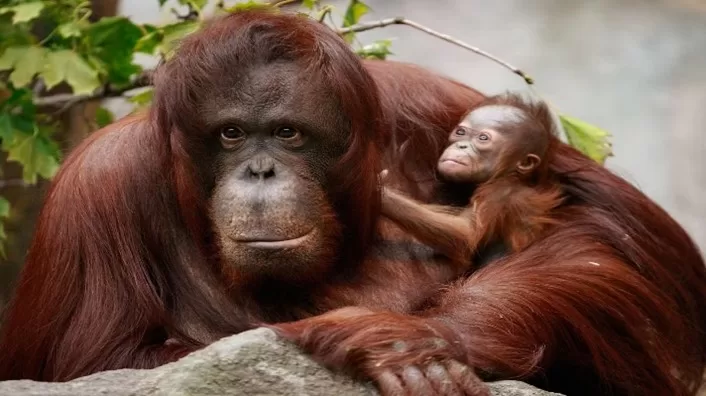
- Orangutans are great ape’s native to the rainforests of Indonesia and Malaysia.
- They are now found only in parts of Borneo and Sumatra.
- They have proportionally long arms and short legs and have reddish-brown hair covering their bodies.
- Bornean and Sumatran orangutans differ a little in appearance and behavior.
- The Bornean orangutan is estimated as Endangered as per IUCN status.
- The Sumatran are categorized as Critically Endangered as per IUCN status.
- The Tapanuli orangutan is the most endangered of all great apes.
Source: THE HINDU
Previous Year Questions
Q.1) With reference to India’s biodiversity, Ceylon Frogmouth, Coppersmith Barbet, Gray Chinned Minivet and White-throated Redstart are (2020)
- Birds
- Primates
- Reptiles
- Amphibians
Q.2) Consider the following statements: (2019)
- Asiatic lion is naturally found in India only
- Double-humped camel is naturally found in India only
- One-horned rhinoceros is naturally found in India only
Which of the statements given above is/are correct?
- 1 only
- 2 only
- 1 and 3 only
- 1, 2 and 3
Syllabus
- Mains – GS 3 (Security)
Context: Ransomwares have emerged as the most predominant of malicious cyberattacks worldwide.
About Cyberattacks:

- Cyberattacks are unwelcome attempts to steal, expose, alter, disable or destroy information through unauthorized access to computer systems.
- Typically such forms of attacks to keep networks from functioning after encrypting data, are carried out by ransomware-seeking entities.
- In ransomware, the perpetrators demand hefty payments for the release of withheld data.
Recent cases of ransomware attacks
- AIIMS Cyberattack: The ransomware attack was faced by the servers of India’s premium institute, the All India Institute of Medical Sciences.
- Nearly 40 million health records were compromised and it took over two weeks for the systems to be brought online.
- Cyberattack on Solar Industries Limited: A ransomware gang, BlackCat, breached the parent company of Solar Industries Limited, one of the Ministry of Defence’s ammunition and explosives manufacturers, and extracted over 2 terabytes of data.
- Overall data: Data shows that over 75% of Indian organisations have faced such attacks, with each breach costing an average of Rs.35 crores of damage.
Reasons for increasing Cyberattacks:
- Increasing dependency on technology:
- As we grow faster, more and more systems are being shifted to virtual space to promote access and ease of use. However, the downside to this trend is the increased vulnerability of such systems to cyber-attacks.
- Asymmetric and covert warfare: Unlike, conventional warfare with loss of lives and eyeball-to-eyeball situations, cyber warfare is covert warfare with the scope of plausible deniability, i.e. the governments can deny their involvement even when they are caught.
- Therefore, cyber warfare has increasingly become the chosen space for conflict between nations.
- Lack of robust law enforcement mechanisms: India’s approach to cyber security has so far been ad hoc and unsystematic.
- Despite a number of agencies, policies and initiatives, their implementation has been far from satisfactory.
- Adverse relations with China: China is considered one of the world leaders in information technology.
- Therefore, it is expected to have capabilities to disable or partially interrupt the information technology services in another country.
- Combined with the recent border standoff and violent incidents between the armies of the two countries, the adversity in relations is expected to spill over to attacking each other’s critical information infrastructure.
- Asymmetric and covert warfare: Unlike conventional warfare with loss of lives and eyeball to eyeball situations, cyber warfare is covert warfare with the scope of plausible deniability, i.e. the governments can deny their involvement even when they are caught.
- Lack of International Coordination: International cooperation and consensus is missing in this field.
- Low digital literacy among the general public and digital gaps amongst nations create an unsustainable environment in the cyber domain.
- It is often reported that people are duped easily by click-baiting them into clicking interesting content, which often has malware attached to itself.
Challenges associated with cyberattacks:
- Need of a cyber security policy: With cyber threats capable of undermining our critical infrastructure, industry and security, a comprehensive cyber security policy is the need of the hour.
- Scarcity of workforce: Most organisations lack the tools to identify cyberattacks, let alone prevent them.
- India also faces an acute scarcity of cybersecurity professionals.
- Nearly two-thirds would find it challenging to respond to a cybersecurity incident due to the shortage of skills within their team.
- India is projected to have a total workforce of around 3,00,000 people in this sector in contrast to the 1.2 million people in the United States.
- Digital Geneva Convention: Most of our organisations are private, and their participation remains limited in India’s cybersecurity structures.
- They would be advised to look at the Digital Geneva Convention, where over 30 global companies have signed a declaration to protect users and customers from cyber breaches and collaborate with like-minded intergovernmental and state frameworks.
- Need for a global framework: With most cyberattacks originating from beyond our borders, international cooperation would be critical to keeping our digital space secure.
India’s Preparedness to Ensure Cybersecurity:
- Banning of unsafe apps: India had banned apps that posed a threat to security.
- India had banned many apps (mostly of Chinese origin), which were found to be unsafe for usage by Indian citizens.
- Awaited National cybersecurity strategy: Comprehensive plan in preparing & dealing with cyber-attacks (Pre, Post and During the attack).
- Indian Cyber Crime Coordination Centre (I4C): Launched in 2018, It is an apex coordination centre to deal with cybercrimes.
- Evolving Technology: Cyber attackers are continuously working on novel ways to sabotage the systems.
- CERT-In (Cyber Emergency Response Team, India): is an office within the Ministry of Electronics and Information Technology of the Government of India.
- It is the nodal agency to deal with cyber security threats like hacking and phishing.
- It strengthens security-related defence of the Indian Internet domain.
- National Cyber Security Policy, 2013: The policy provides the vision and strategic direction to protect the national cyberspace.
- Cyber Swachhta Kendra: Launched in 2017, these helps users to analyse and keep their systems free of various viruses, bots/ malware, Trojans, etc.
- Indian Cyber Crime Coordination Centre (I4C): Launched in 2018, It is an apex coordination centre to deal with cybercrimes.
- Cyber Surakshit Bharat: It was launched by the Ministry of Electronics and Information Technology (MeitY) in 2018 with an aim to spread awareness about cybercrime and building capacity for safety measures for Chief Information Security Officers (CISOs) and frontline IT staff across all government departments.
- The Cyber Warrior Police Force: It was organised on the lines of the Central Armed Police Force in 2018.
- Personal Data Protection Bill: The bill mandates the strengthening of data infrastructure by private companies to safeguard the data of individuals.
- Information Technology Act, 2000 (Amended in 2008): It is the main law for dealing with cybercrime and digital commerce in India.
- National Critical Information Infrastructure Protection Centre (NCIIPC) was created under Section 70A of IT Act 2000 to protect Cyberinfrastructure.
Way Forward:
- Human resource is crucial and there is an urgent need to create an informal Indian team of Cyber Warriors.
- The critical infrastructure managers should also be well trained in cyber warfare and well equipped with all the technologies for isolating viruses and attacks.
- There should be a reward for white hackers who can highlight their shortcomings.
- The managers and common mass must be made aware.
- There is a need to enhance the general awareness levels of the government installations as well as the general public to counter such threats.
- Separate wing under Army or Navy as Cyber Command on lines of US.
- The need of the hour is to come up with a futuristic National Cyber-Security Policy which allocates adequate resources and addresses the concerns of the stakeholders.
- Similarly, there is a need for quicker up-gradation of the existing infrastructure as information technology is a fast-evolving field and there is a need to stay ahead of the competition.
Cooperation with G20:
- The G-20 summit this year in India, which will see participation by all the stakeholders driving the global levers of power, is a rare opportunity to bring together domestic and international engagement groups across the spectrum, and steer the direction of these consultations.
- India could try to conceptualise a global framework of common minimum acceptance for cybersecurity.
Source: The Hindu
Syllabus
- Mains – GS 3 (Economy)
Context: Last week, CSO released the inflation data, it showed that in January, India’s retail inflation surged by 6.5%.
- In other words, the general price level facing the consumers in January 2023 turned out to be 6.5% higher than the price level in January 2022; this is called a year-on-year (or y-o-y) growth rate.
About Inflation:
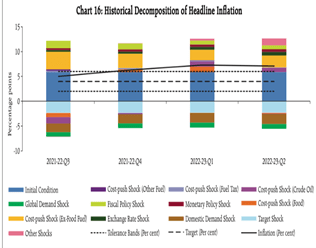
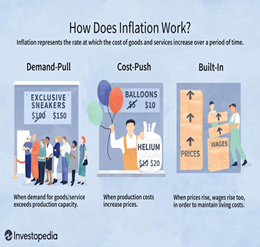
- Inflation refers to a sustained increase in the general price level of goods and services in an economy over a period of time.
- It is the rise in the prices of most goods and services of daily or common use, such as food, clothing, housing, recreation, transport, consumer staples, etc.
- Inflation measures the average price change in a basket of commodities and services over time.
- The opposite and rare fall in the price index of this basket of items is called ‘deflation’.
- Inflation is indicative of the decrease in the purchasing power of a unit of a country’s currency.
- This is measured in percentage.
Measures of Inflation in India:
- In India, the Ministry of Statistics and Programme Implementation measures inflation.
- There are two main set of inflation indices for measuring price level changes in India
- the Wholesale Price Index (WPI) and the Consumer Price Index (CPI).
- GDP deflator is also used to measure inflation.
Significance of Inflation spike in recent times:
- The headline retail inflation rate was 7.4% in September 2022 but since then it was fast losing steam every month and fell to 5.7% in December.
- This moderation had convinced many to demand that the RBI should avoid raising interest rates — something the RBI did not do when it met on February 8.
- In fact, the RBI raised the repo rate the interest rate at which it lends money to the banking system by 25 basis points (100 basis points make up a full percentage point).
- RBI raises the repo rate when it believes that inflation is not in control.
- Higher interest rates drag down overall demand for goods and services by making loans costlier.
- Lower demand is expected to cool down inflation.
- The recent surge was also an unexpected event — most economists and observers expected inflation to rise by just 6% and it has renewed the apprehensions of the RBI raising the interest when it meets again in April.
- RBI’s Monetary Policy Committee (MPC) meets every two months to reconsider its monetary policy stance.
- As increase in interest rate, while doing its bit towards containing inflation, impacts on India’s economic growth.
- To be sure, there is a constant trade-off between maintaining price stability (read containing inflation) and boosting growth (which hopefully creates jobs and reduces unemployment)
Therefore, if inflation stays persistently high (‘sticky’), it would necessitate the RBI to keep raising interest rates or, at the very least, keep them at a high level for a longer period and, in doing so, hurt India’s economic recovery out of the twin shocks of the Covid pandemic and the Russia-Ukraine war.
Reasons for recent Inflation trends:
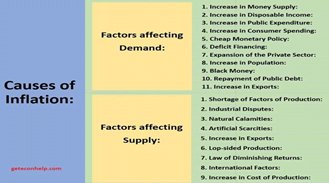
- Inflation being sticky essentially means that inflation is taking longer than expected to fall.
- Essentially, higher food and fuel prices have seeped into the broader economy and made other things costlier.
- “A deeper dive into the core inflation basket suggests that firms continued to pass on higher input costs to consumers, while inflation is moderating in the services sector.
- Core goods inflation continued to inch up to 6% y-o-y in January from 7.5% in December and 7.1% six months back.
- Core services inflation, by contrast, has progressively been moderating from 5.5% in September to 5.0% in January
- Rise in food and fuel prices got increasingly generalised over ensuing months. This was reflected in highly elevated and sticky core inflation.
- Unprecedented input cost pressures got translated to output prices, particularly goods prices, in spite of muted demand conditions and pricing power.
- As the direct effects of the conflict waned and international commodity prices softened, the strengthening domestic recovery and rising demand enabled pass-through of pent-up input costs, especially in services, adding persistence to elevated inflationary pressures.
However, for what it is worth, India is not the only country facing sticky inflation; many others such as the US and countries in the euro zone — are also struggling to extricate themselves from sticky inflation.
Way Forward:
Both the government and Reserve Bank of India try to tackle inflation with their policies which are known as Fiscal and Monetary Policies respectively. Fiscal policies correspond to tax related measures taken by government to control inflation (money supply). RBI through its various monetary policies limit the money supply by altering rates like CRR, Repo, Reverse Repo etc. Administrative measures taken by government like strengthening of Public Distribution System also plays a crucial role in curbing inflation.
Source: Indian Express
Previous Year Questions
Q.1) With reference to the Indian economy, consider the following statements:
- If the inflation is too high, Reserve Bank of India (RBI) is likely to buy government securities.
- If the rupee is rapidly depreciating, RBI is likely to sell dollars in the market.
- If interest rates in the USA or European Union were to fall, that is likely to induce RBI to buy dollars.
Which of the statements given above are correct? (2022)
- 1 and 2 only
- 2 and 3 only
- 1 and 3 only
- 1, 2 and 3
Q.2) With reference to the India economy, what are the advantages of “Inflation-Indexed Bonds (IIBs)”?
- Government can reduce the coupon rates on its borrowing by way of IIBs.
- IIGs provide protection to the investors from uncertainty regarding inflation.
- The interest received as well as capital gains on IIBs are not taxable.
Which of the statements given above are correct? (2022)
- 1 and 2 only
- 2 and 3 only
- 1 and 3 only
- 1, 2 and 3
Practice MCQs
Q.1) Consider the following statements regarding National Agriculture Market or eNAM:
- It was launched with the objective of integrating the existing Mandis into a “One Nation One Market” for agricultural commodities in India.
- Small Farmers Agribusiness Consortium (SFAC) is the lead agency for implementing e-NAM.
- It functions under the aegis of the Ministry of Electronics and Communications.
Which of the statements given above are correct?
- 1 and 2 only
- 2 and 3 only
- 1 and 3 only
- 1 2 and 3
Q.2) Consider the following statements regarding National Agricultural Cooperative Marketing Federation of India Ltd.(NAFED):
- It is registered under the Multi-State Co-operative Societies Act.
- Agricultural farmers are the main members of Nafed, who have the authority to say in the form of members of the General Body.
Which of the statements given above is/are correct?
- 1 only
- 2 only
- Both 1 and 2
- Neither 1 nor 2
Q.3) Consider the following rivers:
- Dhanei
- Badanadi
- Ken
Which of the above is/are tributaries of Rushikulya river:
- 1 and 2 only
- 2 only
- 3 only
- 1 and 3 only
Comment the answers to the above questions in the comment section below!!
ANSWERS FOR ’ 27th February 2023 – Daily Practice MCQs’ will be updated along with tomorrow’s Daily Current Affairs.st
ANSWERS FOR 25th February – Daily Practice MCQs
Q.1) – b
Q.2) – a
Q.3) – d













